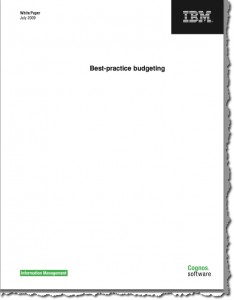Ready for 2013? – What Comes First, the Plan or the Budget?
The 2013 Planning and Budgeting Process
The objective of this series of posts is to outline a 2013 “preparation process” where you end up having a plan and a budget that is a stepping stone to a position as the global market leader in the future and where the stakeholders are 100% aligned and committed to execute the plan and deliver the numbers for 2013.
What comes first, the plan or the budget?
To make the budget come to fruition, you need a plan. To execute the plan you need resources, which are allocated through the budget. Plan and budget go hand in hand.
That may not always be the case in real life. Have you ever received a budget that says: Increase revenue with 15%, improve the gross margin with 6% and reduce your operating expenses with 5%. Your job is to execute within this framework. You have to make and execute a plan, but you cannot influence the budget (accept it or quit).
As an Independent Software Vendor I assume you are controlling the planning and budgeting process yourself. Some corporate executives sitting 5,000 miles away and protected by layers of corporate middle management do not dictate any budget objectives and framework.
If you have not read the first 7 blog posts in this “Ready for 2013?” series, I recommend you do so. Commencing the planning and budgeting activities without the preparation described in post 1-7 is much too big a risk.
The Process Schedule
I assume you want the budget, the plan and all associated frameworks (commission plans, marketing plans, hiring plans, etc.) to be ready before the end of December 2012. Depending on the size of your organization this means that you will have to start the planning process in Q3.
The planning process is obviously an additional operational burden on the organization at a time where year-end closing is already a stress factor. Knowing the schedule well in advance and having it integrated as a part of your operational framework makes the process less stressful.
A 2013 budget/plan schedule could look like this:
 If you follow this schedule you must announce the planning guidelines and schedule no later than the end of September. You will then be able to run the Kick-off in the first week of January.
If you follow this schedule you must announce the planning guidelines and schedule no later than the end of September. You will then be able to run the Kick-off in the first week of January.
A. Budget and Planning Guidelines
Depending on the size of your organization the budget and planning effort will involve several people. There is no value in leaving the format and the level of documentation to each participant. On the other hand you must give the participants ample time and information to learn how to operate within the given guidelines.
Your CFO will most likely assume the role as “the budget engineer” and he will also provide major portions of the data on cost of goods sold (COGS) and operational expenses (OPEX). There is no need to ask the P&L (and cost center) managers for data that already resides with the CFO.
I strongly recommend starting your 2013 planning process defining the format and level of documentation you will require from the parties involved. I also recommend being quite thorough documenting all lines in your budget. It should be possible for someone, who was not involved in the budgeting process, to reconstruct each budget line. Ensure that each budget line is assigned to an individual.
For some reason it seems to be difficult for people to write down in plain text why a number in a budget line is as it is. Be persistent. Ask for plain text explanations.
Excel? – No!
 Unless you are a very small company and one person has the full overview, Excel is not the budgeting tool of choice. Find and implement a genuine budgeting software framework.
Unless you are a very small company and one person has the full overview, Excel is not the budgeting tool of choice. Find and implement a genuine budgeting software framework.
You can find an en excellent review of the issues related to budgeting in the IBM whitepaper: Best-practice Budgeting. The whitepaper is written for larger companies, but most of the considerations apply to SMB companies also.
B. 2012 Forecast
In the 2013 budget and budget review process you will want to compare with 2012. I recommend making a 2012 forecast, which is the one, used during the budget and planning process. Most of the operational expenses (OPEX) will be quite easy to forecast while revenue (REV) and cost of goods sold (COGS) may be more difficult. You always have the option of adjusting your 2012 forecast during the planning period if the outlook changes.
C. 2013 Budget Key Targets
There may be situations where you want to set the key targets for 2013 before the detailed budgeting and planning commences.
Let’s assume you are operating in a market with an expected 6% growth in 2013. You believe your value proposition is strong enough to justify growing revenue 50% and you want the sales and marketing staff working on initiatives and plans making it happen. You want them to prepare the penetration of international markets and you want to remain cash positive throughout 2013.
It is tempting for any CEO to ask the staff to come back from the budgeting and planning exercise with something matching company ambitions. However, it is also dangerous.
Commitment and ownership to a budget and a plan is crucial. Never give anybody the opportunity to claim that the budget and the plan is not theirs. Over-achievement is seldom a major issue, but under-achievement always requires an explanation. The first excuse someone will look for is: “This is not my budget/plan”.
This doesn’t mean that you can only work bottom-up and that you will have to accept anything, which is being brought forward. But it does mean that you will have to do your selling and take the fights up front, when major differences occur.
If you have executed the recommendations from the previous posts in the “Ready for 2013” series, it is very unlikely that there will be major disagreement about objectives. In this case you can choose a clean bottom-up process, which always gives the highest degree of ownership and commitment.
D. Submit Budget and Plan 1 (BP-1)
BP-1 is the first iteration. P&L (and cost center) managers are submitting their budgets and their plans. Management can consolidate the budgets and review the plans. The documentation delivered with BP-1 should be adequate for management to justify if the budget/plan is sufficiently solid and balanced.
E. BP-1 Review
The budget and plan reviews are “workshops” where the consistency and the alignment with overall objectives and guidelines are verified. P&L managers are making their presentations and executive management is giving them a “hard time”.
The term “review” certainly has a negative connotation for many people. Although many consider a “review” a “hostile” type of get-together, there is no way around it. Predicting and making the future, as a market leader, requires a frank discussion of ambitions, opportunities, approaches, resources and so on.
By the end of the review P&L managers as well as executive management will go back and adjust the budget and plan preparing for a second iteration.
(If you do not enjoy and see the benefit of the budget and plan reviews, you may be in the wrong place. It is an integrated discipline in any management position.)
F. Submit Budget and Plan 2 (BP-2)
BP-2 is the second iteration. P&L managers are submitting their revised budgets and their plans. Management can consolidate the adjusted budgets and review the adjusted plans. The documentation delivered with BP-2 should be adequate for management to finalize a preliminary budget/plan.
G. BP-2 Review
A new round of budget/plan workshops are performed.
By the end of the 2nd review P&L managers as well as executive management will go back and adjust the budget and plan preparing for the last iteration.
You may need several iterations before you can finalize the budget, but be careful. Although the devil lies in the detail, there is no point in fighting over the peanuts. It’s better for executive management to accept budgets and plans which are “owned” by the P&L managers, than to dictate the numbers. If too big a gap exists by the end of iteration 2 something or someone is wrong, and you are facing a fundamental management challenge, which is not related to the budget.
H. Submit Final Budget & Plan
The changes and adjustments agreed to during the BP-2 reviews are submitted and consolidated. Final corrections are made and agreed to.
I. Final Budget/Plan Release
I have performed consulting with many companies where there was confusion about what the final budget actually was. This should never be the case. Depending on the underlying IT platform the budget will be uploaded to the reporting system and used for all reporting of actuals versus budget. The associated documentation is made available to the respective P&L managers and will serve as a great support tool next time you need to revise the budget/plan.
J. Associated Frameworks
There are a number of associated frameworks, which cannot be completed before the budget and the plan have been finalized. The two most prominent are:
- Compensation plans
- KPI’s
KPI’s are defined to serve as early warning “traffic lights”. Responding to actual versus budget figures makes your ability to react much too slow. You must react when you can foresee that you will not meet the budget or that you can outperform the budget.
Compensation plans should be tied to KPI’s and performance.
K. Kick-off
Communicating the final budget and the final plans to the entire organization is a must. The entire management team should make their contributions, but again a warning:
Staff is normally not interested in the budget details. Presenting slides with numbers make people disconnect.
Paint the big picture and focus on those elements which affects everybody. Focus on the vision, the mission, the ambition, the 3-5 year perspective and the implications for the entire organization. Demonstrate a united management team passionately committed to the course, the plan and the objectives. Make it a fun and entertaining experience.
And a personal note: Don’t bring in an external keynote speaker to cheer up the crowd. (You can use external help arranging and executing the event). The kick-off is an internal event and management must sell the messages and create the enthusiasm and the winning spirit themselves.
Other posts in this “Ready for 2013? – Lean Planning & Budgeting” series:
The objective of the blog posts is to outline a 2013 “preparation process” where you end up having a plan and a budget, which is a stepping stone to a position as a the global market leader in the future and where the stakeholders are 100% aligned and committed to execute the plan and deliver the numbers for 2013
#1: Perform an Alignment Check before Planning and Budgeting
#2: Get the Key People Involved up Front
#3: How to do an Alignment and Identification Check
#4: The Revenue Challenge
#5: Planning Fundamentals
#6: Mitigating risk and exploiting opportunity
#7: Mission/Vision and the 3-5 Year Perspective
#8: What Comes First, the Plan or the Budget?
#9: Defining Key Performance Indicators for Plan and Budget Follow-up
#10: The People on the Bus









